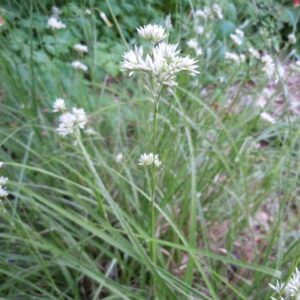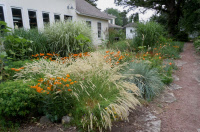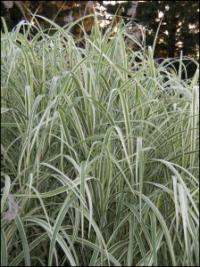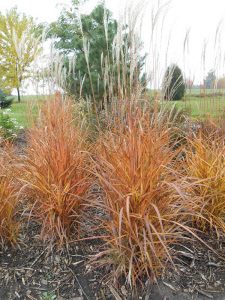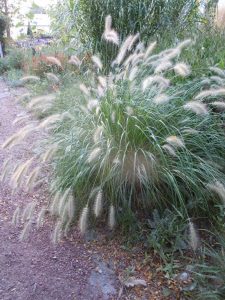Grasses, Sedges & Rushes
Showing 17–24 of 26 results
-
Koeleria macrantha syn. Koeleria cristata June grass
whitish spike-like panicles
Erect ivory spike-like panicles June thru August, poke above a neat mound of erect grass blades.
Size: 2' x 18"
Care: Sun in well drained to moist well-drained soil
Native: prairies of No. America, Wisconsin native.Koeleria named by Linnaeus for grass specialist and professor at Mainz, G.L. Koeler (1765-1806). Cheyenne Indians tied June grass to the heads of Sun Dancers to deter them from getting tired and made paint brushes from it. New Mexico’s Jemez Indians made brooms from tied blades. Isleta and Havasupai Indians ate ground seeds in bread and as mush. Liberty Hyde Bailey (1933) said: “Sometimes cultivated for lawn decoration in open dry ground.” Meriwether Lewis collected this at Camp Chopunnish in Idaho on June 10, 1806 while waiting for snow melt to safely cross the Bitterroots on the expedition’s way home.
-
Luzula nivea Snowy woodrush 5-8
Very unusual & ornamental grass. Dense white flower clusters in June-July. Leaves are evergreen with hairy margins. One of few grasses for shady areas.
Very unusual & ornamental grass. Dense white flower clusters in June-July. Leaves are evergreen with hairy margins. One of few grasses for shady areas.
Size: 24” x 24”
Care: part shade to shade in moist well-drained to well-drained soil.
Native: Central and southern Europe, AlpsNamed by Linnaeus in 1753. Genus name Latin meaning “light.” Nivea means “snow white.” According to Liberty Hyde Bailey the flowers are “useful in dried bouquets.”(1933)
-
Melica ciliata Silky spike melic grass Z 5-9
Ornamental arching white spikes from June through mid-summer. Especially nice for its early bloom, long before most grasses.
Ornamental arching white spikes from June through mid-summer. Especially nice for its early bloom, long before most grasses.
Size: 2' x 12"
Care: full sun in moist well-drained to moist soil.
Native: Eurasia to North Africa
Wildlife Value: Deer resistantMelica is Greek for “sweet grass.” This species collected before 1753.
-
Miscanthus sinensis ‘Variegatus’ Striped Maiden grass Z 4-
Vertical white srtipes on 4' arching green grass blades, inflorescenses coppery russet in fall,
Vertical white srtipes on 4′ arching green grass blades, inflorescenses coppery russet in fall
Size: 6' x 4' clump forming
Care: Sun moist well-drained soil. Cut back in spring.
Native: S.E. AsiaMiscanthus is Greek meaning stem and flower. Mentioned in Man’yoshu, a Japanese anthology of poems written in the 8th century, where it symbolized the melancholy of autumn. This variegated form frequently used in Victorian bedding designs. American garden cultivation since late 1800’s. Recommended by Gertrude Jekyll, mother of mixed perennial borders, in 1908, for its “great white striped” foliage.
-
Miscanthus sinensis subsp. purpurascens syn. Miscanthus ‘Purpurascens’ Flame grass Z 4-9
Flame grass starts in spring tinged with red in the leaves, increasing as summer passes. By fall the leaves turn brilliant orange-red, darkening to burgundy by winter. It retains its color for a few months. Tassel-like inflorescences appear in late summer, opening into creamy plumes by fall. It is upright and clump-forming.
Flame grass starts in spring tinged with red in the leaves, increasing as summer passes. By fall the leaves turn brilliant orange-red, darkening to burgundy by winter. It retains its color for a few months. Tassel-like inflorescences appear in late summer, opening into creamy plumes by fall. It is upright and clump-forming.
Size: 4-5’ x 3-4’
Care: sun to part shade in any soil - sandy to clay soils. Cut back in late winter to spring.
Native: Japan
Wildlife Value: Deer resistant and tolerant of Walnut trees.Miscanthus is Greek meaning stem (“miskos) and flower (“anthos”). Miscanthus mentioned in Man’yoshu, a Japanese anthology of poems written in the 8th century, where it symbolized the melancholy of autumn. This specific plant described by Swedish botanist Nils Johan Andersson (1821-1880) in 1855 in Öfvers. Kongl. Vetensk.-Akad. Förh. 12:167.
-
Pennisetum orientale Oriental fountain grass Z 5-10
Showy, white to pinkish inflorescences summer thru fall.
Showy, white to pinkish inflorescences summer thru fall. Richard Darke, grass guru, describes this as “One of the most striking hardy fountain grasses. Low growing, compact and exceptionally floriferous … Blooms over an unusually long period from late June through October”
Size: 2' x 2'
Care: sun in well-drained soil or moist well-drained soil. Deer resistant and drought tolerant.
Native: central & SW Asia
Awards: Elisabeth Carey Miller Botanical Garden Great Plant PicksThe plant is named for its soft inflorescences; Latin penna and seta mean feather-bristle. This species collected before 1821.
-
Schizachyrium scoparium syn. Andropogon scoparium Little bluestem Z 3-9
Wispy, feather-like seedheads atop blue-grey foliage that turns plum-orange-red in fall.
Wispy, feather-like seedheads atop blue-grey foliage that turns plum-orange-red in fall
Size: 18" x 12"
Care: sun in well-drained soil.
Native: all No. America, Wisconsin native.
Wildlife Value: leaves are food for Skipper butterfly caterpillars and seeds food for songbirdsComanche used it to remedy syphilitic sores. Lakota made soft, wispy seedheads into liners for moccasins. Collected by French plant hunter André Michaux (1746-1802) in America’s prairies c. 1790
-
Sesleria autumnalis Autumn Moor Grass Z 5-9
Fresh-green spring narrow blades of grass in summer add airy purplish flower spikes with silver-white stamens on this low mounding, arching grass. Blades have a striking yellow-green color that sometimes develops a soothing golden autumn tint. Spike-like silvery flowers rise above the leaves and mature into soft tan seed heads by autumn.
Fresh-green spring narrow blades of grass in summer add airy purplish flower spikes with silver-white stamens on this low mounding, arching grass. Blades have a striking yellow-green color that sometimes develops a soothing golden autumn tint. Spike-like silvery flowers rise above the leaves and mature into soft tan seed heads by autumn.
Size: 16-18” x 12-18”
Care: sun to part shade in moist well-drained to well-drained soil, drought tolerant
Native: SE Europe east to Caucusus
Wildlife Value: walnut, salt and deer tolerant
Awards: Royal Horticultural Society Award of Garden Merit. Gardens Illustrated “100 Must-Have Garden Plants,” 2013.Collected in Slovenian mountains near Idria, c. 1760 by and 1st described in Flora Carniolica by Giovanni Antonio Scopoli (1723-1788) physician, naturalist and author. Sesleria is named to honor Leonardo Selser, 18th century Italian botanist and physician, contemporary and likely friend of Scopoli


